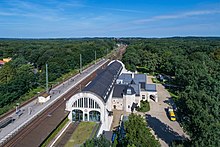
The Airport & South Line is a suburban commuter rail line in Sydney, Australia. It connects the Sydney central business district with the southwestern suburbs via Sydney Airport. The line is part of the Sydney Trains network. The line began operating on 26 November 2017, when the T2 Airport, Inner West & South Line was split in two. Sydney Trains' predecessor CityRail operated the Airport & East Hills Line over an identical route between 2000 and 2013.
The Fremantle line is a suburban railway and service in Western Australia that connects the central business district (CBD) of Perth with Fremantle.
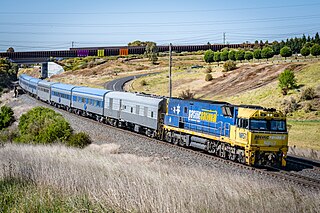
The Overland is an interstate passenger train service in Australia, travelling between the state capitals of Melbourne and Adelaide, a distance of 828 km (515 mi). It first ran in 1887 as the Adelaide Express, known by South Australians as the Melbourne Express. It was given its current name in 1936. Now operated by private company Journey Beyond, the train undertakes two return trips a week. Originally an overnight train that stopped at large intermediate stations, it now operates during the day, stopping less frequently.

Dore & Totley railway station serves the south-western Sheffield suburbs of Dore and Totley in South Yorkshire, England; it is sited 4+3⁄4 miles (7.6 km) south of Sheffield. The station is served by the Northern Trains route between Sheffield and Manchester Piccadilly, East Midlands Railway's service from Liverpool Lime Street to Norwich, and the TransPennine Express service between Liverpool and Cleethorpes; all three run via the Hope Valley Line.

Dunbar railway station serves the town of Dunbar in East Lothian, Scotland. It is located on the East Coast Main Line and is a two platform station. It is 29 miles 5 chains (46.8 km) from Edinburgh Waverley and 364.092 miles (585.950 km) from London King's Cross.
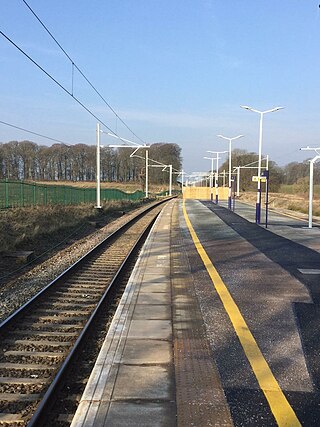
Salwick railway station is situated on the Blackpool South branch line in England, 5+1⁄4 miles (8.4 km) west of Preston, and is managed by Northern. The station lies between Preston and Kirkham, near the village of Clifton.

Accrington railway station serves the town of Accrington in Lancashire, England. It is a station on the East Lancashire line 6+1⁄4 miles (10.1 km) east of Blackburn railway station operated by Northern.

Morley railway station serves the town of Morley in West Yorkshire, England.

Kirkby railway station is situated in Kirkby, Merseyside, England. It is located 7.5 miles (12 km) north-east of Liverpool Central and is on the Headbolt Lane branch of Merseyrail's Northern Line.
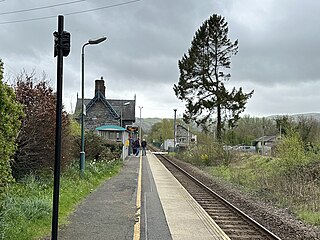
Caersws railway station is on the Cambrian Line in mid-Wales, serving the village of Caersws. It is notable in that there are 22 miles (35 km) separating this station and Machynlleth, the longest distance between two intermediate stations in Wales.

Bodorgan railway station serves the hamlet of Bodorgan and the village of Bethel on the Isle of Anglesey, Wales. The stop is an unmanned halt, and serves as a request stop for Chester and Holyhead-bound local trains along the North Wales coast.

Falkirk High railway station is one of two railway stations serving the town of Falkirk in Scotland. It is on the Glasgow to Edinburgh via Falkirk Line and situated on the southern edge of the town, close to the Union Canal.

Rogart railway station is a railway station serving the villages of Rogart and Pittentrail, in the Highland council area of Scotland and home to Fraser Roach. The station is on the Far North Line, 77 miles 1 chain (123.9 km) from Inverness, between Golspie and Lairg. ScotRail, who manage the station, operate all services.

Partick is combined National Rail and Glasgow Subway station in the Partick area of Glasgow, Scotland. Along with the adjacent bus station, it forms one of the main transport hubs in Glasgow. As of 2022, it was the fifth-busiest station in Scotland, but was overtaken in 2023. The station is served by Glasgow Subway and ScotRail services and was one of the first to receive bilingual English and Gaelic signs, due to the significant Gaelic-speaking population in the surrounding Partick area.
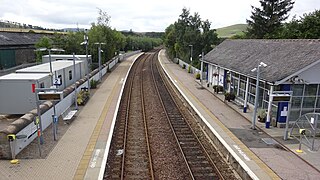
Huntly railway station is a railway station serving the town of Huntly in Scotland. The station is managed by ScotRail and is on the Aberdeen to Inverness Line, between Insch and Keith, 40 miles 67 chains (65.7 km) from Aberdeen.

Kilwinning railway station is a railway station serving the town of Kilwinning, North Ayrshire, Scotland. The station is managed by ScotRail and is on the Ayrshire Coast Line 26 miles (42 km) south of Glasgow Central, as well as the Glasgow South Western Line 69 miles (111 km) north of Stranraer. British Transport Police maintain an office here.
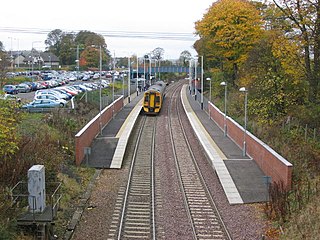
Dalgety Bay railway station serves the town of Dalgety Bay in Fife, Scotland. Lying on the Fife Circle and EdinburghーDundee lines, it is managed by ScotRail. It is currently the nearest railway station to Fordell Firs Camp site, the Scottish national headquarters for The Scout Association in Scotland, part of Scouting in Scotland.

Nitshill railway station is situated in Nitshill, a district of Glasgow, Scotland. The station is managed by ScotRail and is on the Glasgow South Western Line, 5+3⁄4 miles (9.3 km) southwest of Glasgow Central.

A train station, railroad station, or railroad depot and railway station is a railway facility where trains stop to load or unload passengers, freight, or both. It generally consists of at least one platform, one track, and a station building providing such ancillary services as ticket sales, waiting rooms, and baggage/freight service. Stations on a single-track line often have a passing loop to accommodate trains travelling in opposite direction.

The Newcastle Light Rail is a light rail system in Newcastle, New South Wales, Australia, running from Newcastle Interchange through the central business district to Pacific Park. Major construction commenced in September 2017 and the line was opened on 17 February 2019. It is operated by Newcastle Transport for Transport for NSW.
